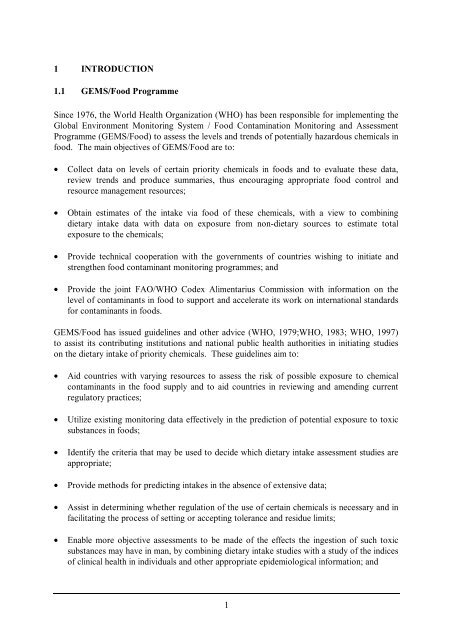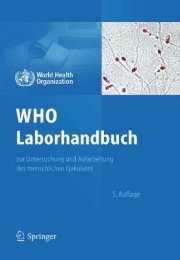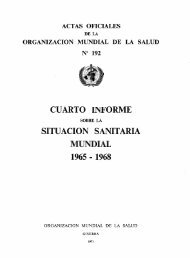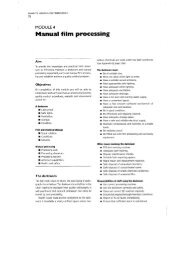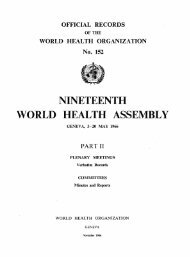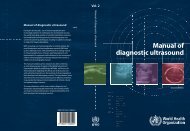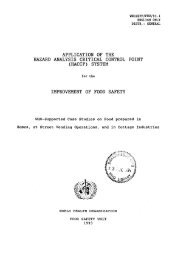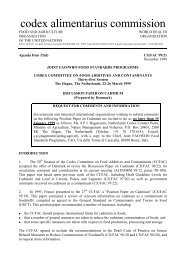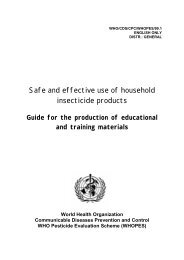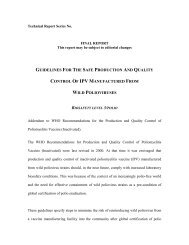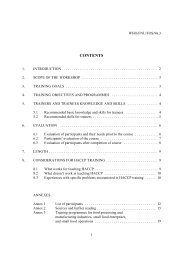GEMS/Food Instructions for Electronic Submission of Data on ...
GEMS/Food Instructions for Electronic Submission of Data on ...
GEMS/Food Instructions for Electronic Submission of Data on ...
You also want an ePaper? Increase the reach of your titles
YUMPU automatically turns print PDFs into web optimized ePapers that Google loves.
1 INTRODUCTION<br />
1.1 <str<strong>on</strong>g>GEMS</str<strong>on</strong>g>/<str<strong>on</strong>g>Food</str<strong>on</strong>g> Programme<br />
Since 1976, the World Health Organizati<strong>on</strong> (WHO) has been resp<strong>on</strong>sible <str<strong>on</strong>g>for</str<strong>on</strong>g> implementing the<br />
Global Envir<strong>on</strong>ment M<strong>on</strong>itoring System / <str<strong>on</strong>g>Food</str<strong>on</strong>g> C<strong>on</strong>taminati<strong>on</strong> M<strong>on</strong>itoring and Assessment<br />
Programme (<str<strong>on</strong>g>GEMS</str<strong>on</strong>g>/<str<strong>on</strong>g>Food</str<strong>on</strong>g>) to assess the levels and trends <str<strong>on</strong>g>of</str<strong>on</strong>g> potentially hazardous chemicals in<br />
food. The main objectives <str<strong>on</strong>g>of</str<strong>on</strong>g> <str<strong>on</strong>g>GEMS</str<strong>on</strong>g>/<str<strong>on</strong>g>Food</str<strong>on</strong>g> are to:<br />
• Collect data <strong>on</strong> levels <str<strong>on</strong>g>of</str<strong>on</strong>g> certain priority chemicals in foods and to evaluate these data,<br />
review trends and produce summaries, thus encouraging appropriate food c<strong>on</strong>trol and<br />
resource management resources;<br />
• Obtain estimates <str<strong>on</strong>g>of</str<strong>on</strong>g> the intake via food <str<strong>on</strong>g>of</str<strong>on</strong>g> these chemicals, with a view to combining<br />
dietary intake data with data <strong>on</strong> exposure from n<strong>on</strong>-dietary sources to estimate total<br />
exposure to the chemicals;<br />
• Provide technical cooperati<strong>on</strong> with the governments <str<strong>on</strong>g>of</str<strong>on</strong>g> countries wishing to initiate and<br />
strengthen food c<strong>on</strong>taminant m<strong>on</strong>itoring programmes; and<br />
• Provide the joint FAO/WHO Codex Alimentarius Commissi<strong>on</strong> with in<str<strong>on</strong>g>for</str<strong>on</strong>g>mati<strong>on</strong> <strong>on</strong> the<br />
level <str<strong>on</strong>g>of</str<strong>on</strong>g> c<strong>on</strong>taminants in food to support and accelerate its work <strong>on</strong> internati<strong>on</strong>al standards<br />
<str<strong>on</strong>g>for</str<strong>on</strong>g> c<strong>on</strong>taminants in foods.<br />
<str<strong>on</strong>g>GEMS</str<strong>on</strong>g>/<str<strong>on</strong>g>Food</str<strong>on</strong>g> has issued guidelines and other advice (WHO, 1979;WHO, 1983; WHO, 1997)<br />
to assist its c<strong>on</strong>tributing instituti<strong>on</strong>s and nati<strong>on</strong>al public health authorities in initiating studies<br />
<strong>on</strong> the dietary intake <str<strong>on</strong>g>of</str<strong>on</strong>g> priority chemicals. These guidelines aim to:<br />
• Aid countries with varying resources to assess the risk <str<strong>on</strong>g>of</str<strong>on</strong>g> possible exposure to chemical<br />
c<strong>on</strong>taminants in the food supply and to aid countries in reviewing and amending current<br />
regulatory practices;<br />
• Utilize existing m<strong>on</strong>itoring data effectively in the predicti<strong>on</strong> <str<strong>on</strong>g>of</str<strong>on</strong>g> potential exposure to toxic<br />
substances in foods;<br />
• Identify the criteria that may be used to decide which dietary intake assessment studies are<br />
appropriate;<br />
• Provide methods <str<strong>on</strong>g>for</str<strong>on</strong>g> predicting intakes in the absence <str<strong>on</strong>g>of</str<strong>on</strong>g> extensive data;<br />
• Assist in determining whether regulati<strong>on</strong> <str<strong>on</strong>g>of</str<strong>on</strong>g> the use <str<strong>on</strong>g>of</str<strong>on</strong>g> certain chemicals is necessary and in<br />
facilitating the process <str<strong>on</strong>g>of</str<strong>on</strong>g> setting or accepting tolerance and residue limits;<br />
• Enable more objective assessments to be made <str<strong>on</strong>g>of</str<strong>on</strong>g> the effects the ingesti<strong>on</strong> <str<strong>on</strong>g>of</str<strong>on</strong>g> such toxic<br />
substances may have in man, by combining dietary intake studies with a study <str<strong>on</strong>g>of</str<strong>on</strong>g> the indices<br />
<str<strong>on</strong>g>of</str<strong>on</strong>g> clinical health in individuals and other appropriate epidemiological in<str<strong>on</strong>g>for</str<strong>on</strong>g>mati<strong>on</strong>; and<br />
1


